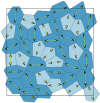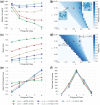Relating cell shape and mechanical stress in a spatially disordered epithelium using a vertex-based model
- PMID: 28992197
- PMCID: PMC5978812
- DOI: 10.1093/imammb/dqx008
Relating cell shape and mechanical stress in a spatially disordered epithelium using a vertex-based model
Abstract
Using a popular vertex-based model to describe a spatially disordered planar epithelial monolayer, we examine the relationship between cell shape and mechanical stress at the cell and tissue level. Deriving expressions for stress tensors starting from an energetic formulation of the model, we show that the principal axes of stress for an individual cell align with the principal axes of shape, and we determine the bulk effective tissue pressure when the monolayer is isotropic at the tissue level. Using simulations for a monolayer that is not under peripheral stress, we fit parameters of the model to experimental data for Xenopus embryonic tissue. The model predicts that mechanical interactions can generate mesoscopic patterns within the monolayer that exhibit long-range correlations in cell shape. The model also suggests that the orientation of mechanical and geometric cues for processes such as cell division are likely to be strongly correlated in real epithelia. Some limitations of the model in capturing geometric features of Xenopus epithelial cells are highlighted.
Figures










Similar articles
-
Decoupling the Roles of Cell Shape and Mechanical Stress in Orienting and Cueing Epithelial Mitosis.Cell Rep. 2019 Feb 19;26(8):2088-2100.e4. doi: 10.1016/j.celrep.2019.01.102. Cell Rep. 2019. PMID: 30784591 Free PMC article.
-
From cells to tissue: A continuum model of epithelial mechanics.Phys Rev E. 2017 Aug;96(2-1):022418. doi: 10.1103/PhysRevE.96.022418. Epub 2017 Aug 31. Phys Rev E. 2017. PMID: 28950595
-
Mechanical Cell Interactions on Curved Interfaces.Bull Math Biol. 2025 Jan 7;87(2):29. doi: 10.1007/s11538-024-01406-w. Bull Math Biol. 2025. PMID: 39775998 Free PMC article.
-
Cell topology, geometry, and morphogenesis in proliferating epithelia.Curr Top Dev Biol. 2009;89:87-114. doi: 10.1016/S0070-2153(09)89004-2. Curr Top Dev Biol. 2009. PMID: 19737643 Review.
-
Taking the strain: quantifying the contributions of all cell behaviours to changes in epithelial shape.Philos Trans R Soc Lond B Biol Sci. 2017 May 19;372(1720):20150513. doi: 10.1098/rstb.2015.0513. Philos Trans R Soc Lond B Biol Sci. 2017. PMID: 28348250 Free PMC article. Review.
Cited by
-
Viscoelastic voyages - Biophysical perspectives on cell intercalation during Drosophila gastrulation.Semin Cell Dev Biol. 2020 Apr;100:212-222. doi: 10.1016/j.semcdb.2019.11.005. Epub 2019 Nov 26. Semin Cell Dev Biol. 2020. PMID: 31784092 Free PMC article. Review.
-
Pressure and curvature control of the cell cycle in epithelia growing under spherical confinement.Cell Rep. 2022 Aug 23;40(8):111227. doi: 10.1016/j.celrep.2022.111227. Cell Rep. 2022. PMID: 36001958 Free PMC article.
-
Decoupling the Roles of Cell Shape and Mechanical Stress in Orienting and Cueing Epithelial Mitosis.Cell Rep. 2019 Feb 19;26(8):2088-2100.e4. doi: 10.1016/j.celrep.2019.01.102. Cell Rep. 2019. PMID: 30784591 Free PMC article.
-
Mechanically-driven growth and competition in a Voronoi model of tissues.ArXiv [Preprint]. 2024 May 13:arXiv:2405.07899v1. ArXiv. 2024. PMID: 38800651 Free PMC article. Preprint.
-
Mechanical characterization of disordered and anisotropic cellular monolayers.Phys Rev E. 2018 May;97(5-1):052409. doi: 10.1103/PhysRevE.97.052409. Phys Rev E. 2018. PMID: 29906905 Free PMC article.
References
-
- Batchelor G. K. (1970) The stress system in a suspension of force-free particles. J. Fluid Mech., 41, 545–570.
-
- Bi D., Lopez J. H., Schwarz J. M. & Manning M. L. (2015) A density-independent rigidity transition in biological tissues. Nat. Phys., 11, 1074–1079.
Publication types
MeSH terms
Grants and funding
LinkOut - more resources
Full Text Sources
Other Literature Sources
Miscellaneous

